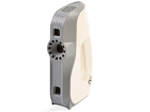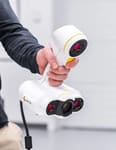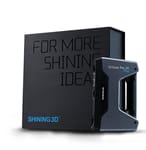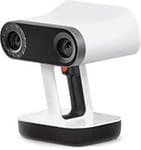Although it was first released back in 2012, the Luxembourg-made Artec Eva has remained one of the go-to handheld 3D scanners on the professional market, fueled in part by their constantly evolving and super powerful Artec Studio software.
As the flagship model in Artec’s 3D scanning product line, the Artec Eva is a full-color 3D scanner that captures medium-to-large-sized objects in a high resolution. Despite it getting slightly long in the tooth, only a few hardware manufacturers have been able to rise to the occasion and compete with the Eva in the professional-grade handheld scanner sector.
At 13,700€ (~$14,685), this white light scanner is a bit pricey for consumers, but the incredible accuracy makes it perfect for a wide range of applications, from the automotive industry to the reconstruction of historical artifacts and beyond.
You might not be able to teach an old dog new tricks, but you can definitely use an older 3D scanner for exciting new applications. So, with that being said, here’s our review of the Artec Eva 3D scanner.
Verdict
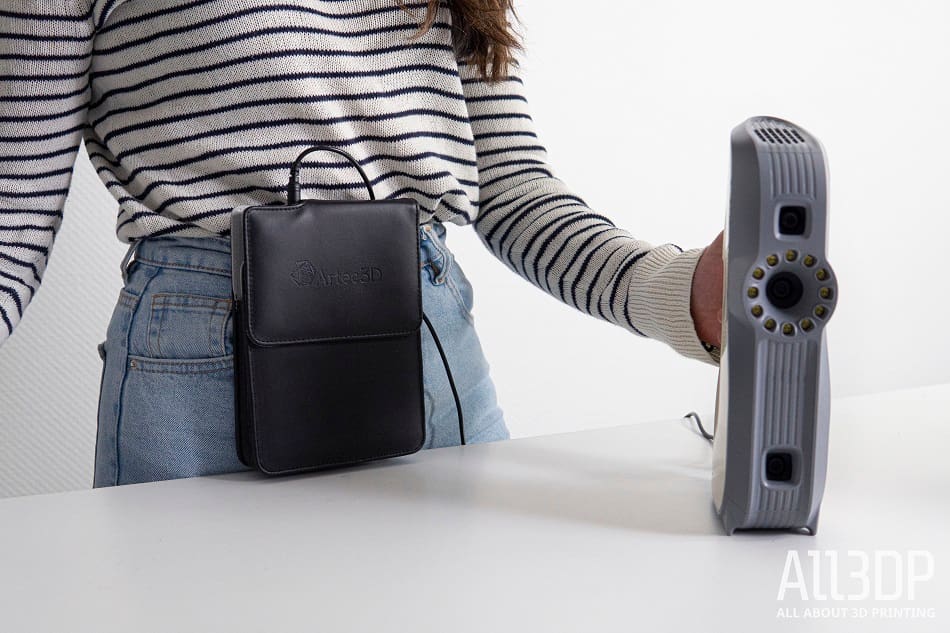
Pros
- Powerful software with advanced features
- Adept at scanning trickier surfaces like hair
- Did we mention the software?
Cons
- Clunky design can make scanning tricky (and tiring)
- Not ideal for smaller-sized objects and flat, plain ones
Clunky hardware and nimble software would be the best way to sum up this machine. Since it was built in 2012, the actual design of the scanner hasn’t changed. This means you need to keep an eye on your laptop or tablet while scanning to know how the process is going (the scanner itself offers no hints), which requires holding both objects simultaneously. It’s a bit of a juggling act and can get tiring for your arms.
But, those concerns aside, the machine’s structured light technology is efficient at picking up objects you scan (including hair), it’s super accurate, and it’s very straightforward to use.
Plus, quarterbacking the whole thing is the Artec Studio software, which is pricey, but worth the investment. Though the scanner’s stayed the same, the software gets continual updates and it shows. If accuracy and reliability are of paramount importance to you, we’d recommend spending the extra cash and picking the Eva over alternatives.
Scanning
Over the last few years, 3D scanning technology has become more accessible and affordable, resulting in an influx of new scanning hardware on the market. This has made it much easier for both consumers and professionals to capture real-world objects and recreate them in the digital format. Whether it be a rare museum artifact or an out-of-production car part, the ever-increasing capabilities of handheld 3D scanning technology have changed the way we approach digital fabrication.
Enter the Artec Eva, a full-color 3D scanner that can capture objects quickly in high resolution and with texture. The machine uses structured light to scan accurately and safely (even on eyes). The scanner is ideal for capturing mid-to-large-sized objects such as automotive components, a human bust, medical devices, and really any physical object you can imagine.
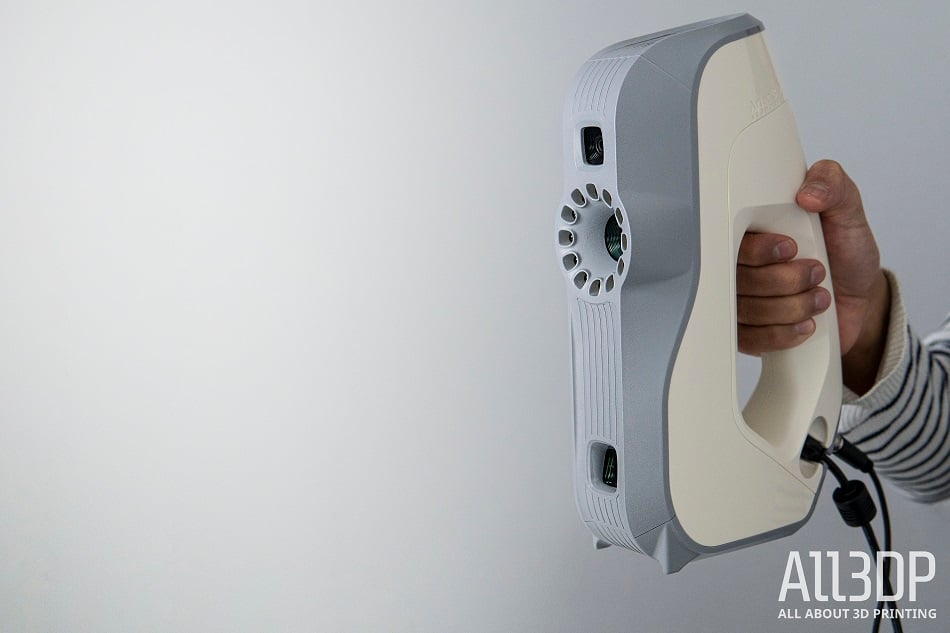
Though it’s not the most beautiful looking scanner on the market (its color scheme reminds us of an old desktop computer from the early 2000s), don’t let the slightly dated design fool you: it’s well up to the task of scanning whatever object you throw in its path.
The hardware is equipped with just two buttons: one to start and pause the scanner and another to stop the process completely. It also features an LED indicator that shows users whether they’re in idle mode, preview mode, or recording mode.
In terms of technical prowess, the Eva can capture a high accuracy of up to 0.1 mm and a resolution of up to 0.5 mm, granting the user with scans that include some of the most intricate object details. This system also offers exceptional scanning speed, capturing up to two million points in a single second. Combine that with the elimination of markers, and you can see why the scanning process is so efficient. Additionally, the ability to capture objects in full-color also enhances both the scanning quality and resulting 3D model.
The Artec Eva is capable of capturing up to 16 frames per second, each of which is automatically aligned in real-time. This makes the entire 3D scanning process very easy and fast, even for objects that have a black or shiny surface (as both tend to cause trouble for many other 3D scanners).
Unlike other common 3D scanning systems, the Artec Eva doesn’t require the use of markers or calibration. Not having to calibrate the machine is a definite perk and it means there’s no wait between turning the scanner on and starting to scan. However, not requiring markers or positioning targets can be a drag.

When it comes to scanning plain, flat surfaces, the Eva will run into trouble. Artec’s recommended solution to this is to draw crosses on the surface (not always possible or desirable) or to stick masking tape intermittently on the surface to create some variety. The problem with this is the software is then not able to automatically delete the masking tape, unlike most software that work using positioning targets. It’s not a dealbreaker, but depending on what you use the scanner for it could get annoying.
We also found scanning smaller-sized objects to be less than a breeze. The scanner really is best-suited towards mid-to-large objects, though there are tricks you can use to scan smaller ones. For example, you can put a large object or colorful background behind a small object to help the Eva stay on track. But, though this generally works, it is annoying and far from ideal (if printing smaller objects is your priority and you want to stay in the Artec family, we’d go for the Space Spider, which is specifically designed for that purpose).
When it comes to scanning people though, the Eva is fully adept, even gamely tackling hair, something most other scanners in its price range balk at. It also picks up fabrics and other materials exceptionally, making it a safe choice for VR applications.
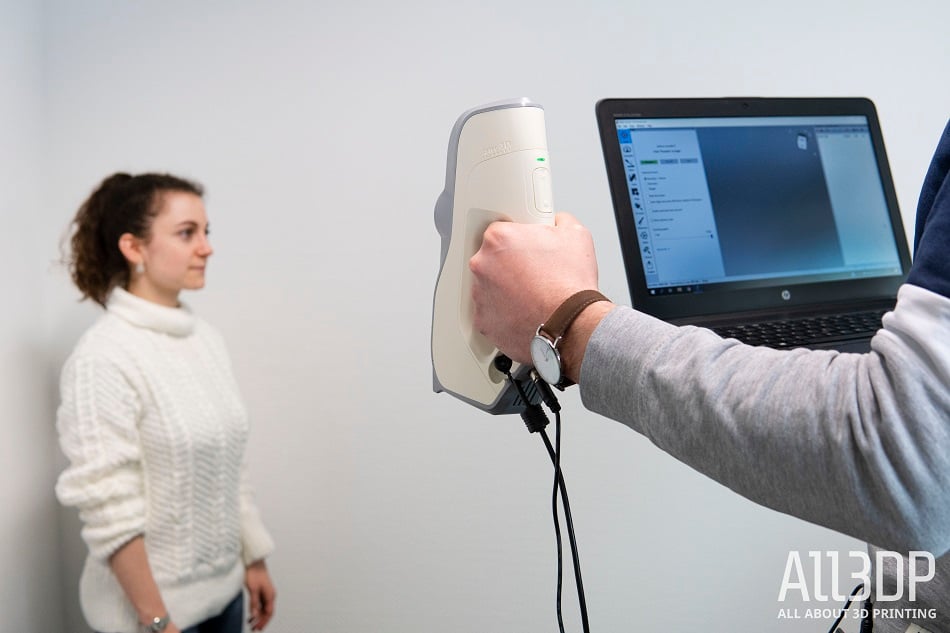
Here’s where this scanner gets frustrating to use: You have to tote around your entire laptop – and the software is demanding on your computer, so odds are you’ve got an extra heavy machine – in one hand (or on a harness), navigating a cluster of wires, while you scan the object with your other hand.
And, you have to keep one eye on your laptop screen to make sure you’ve got the scanner in the right position to pick up the object properly (are you too close? Too far? Have you lost tracking?), while the other eye follows what you’re actually scanning.
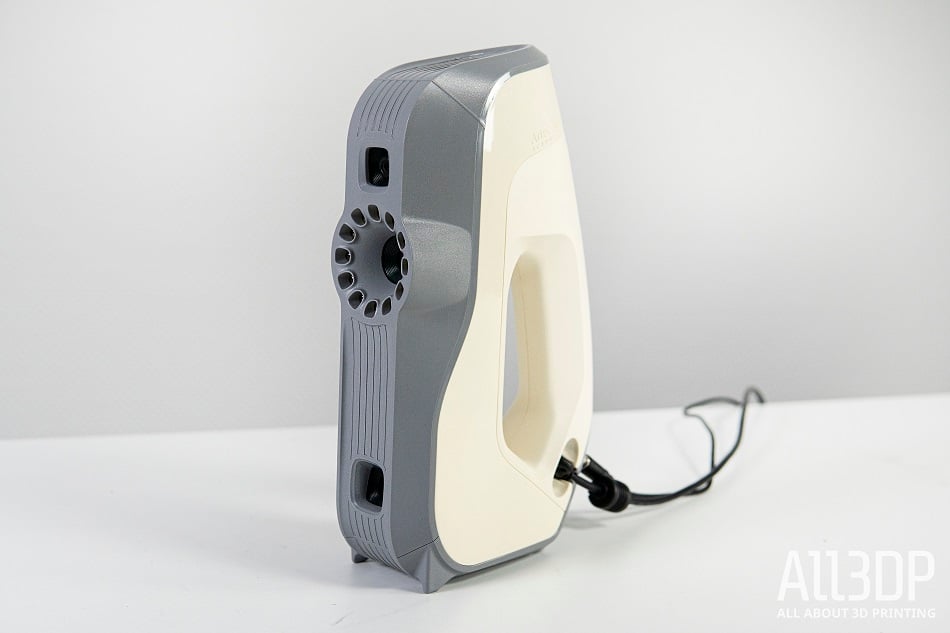
It’s a lot going on at once and it’s further complicated if you have to keep everything plugged into a wall outlet. For this reason, Artec recommends ponying up an extra 600€ for a portable battery pack you can connect the scanner to so you’re not completely ensnared by cables. It comes with a pouch that clips onto your pants, a charger, and a power cable and will give you up to six hours of power.
Though the battery pack frees you from proximity to a wall outlet, the case for it isn’t the best. It fell off a lot of times while we were scanning. We would also recommend a laptop harness or using a tablet instead of holding a laptop because it’s super inconvenient. All these add-ons absolutely help, but if looking cool and 3D scanning is important to you, you’ll have to rethink your priorities.
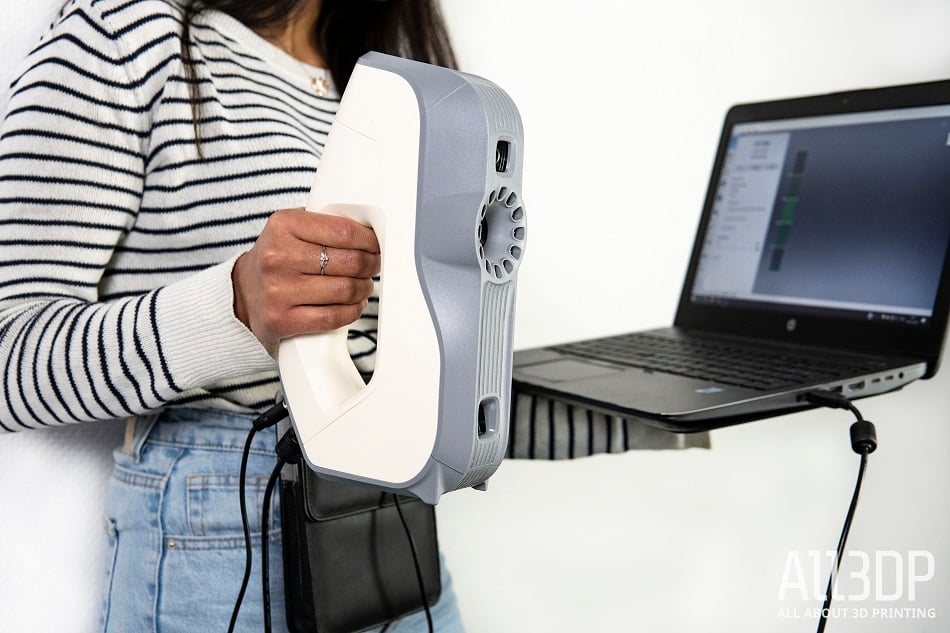
A very chic solution to this problem would be – for those with deeper pockets – to save the $600 on the external power source for your Eva and instead plonk down an additional 9,000€ (~$10,000) for an Artec Leo, which costs a cool 22,700€ (~$25,360).
You won’t have to deal with any wires because the machine is entirely self-contained. There’s a touchscreen directly on the scanner to keep an eye on how it’s going and the data you’ve collected, a rechargeable battery, (a slightly wider field of view), and WiFi connectivity.
But enough about the Leo, this review is about the Artec Eva and – laptop-cum-scanner-balancing and cable drama aside – the machine is fully adept at scanning.
Conclusion
The Artec Eva has a lot to offer – it’s adept at scanning all kinds of textures, geometries, fabrics and even hair (hair!), but where its real value lies is in the Artec Studio software, a pricey, but powerful program that helps you to really perfect your scans. Though the clunky hardware is a bit of a drag, there are workarounds for it – like using a tablet and investing in a battery pack.
Overall, though the Eva isn’t the cheapest or the newest scanner on the market, it’s truly stood the test of time and its software is always getting updates and improvements.
Tech Specs
Here are the technical specifications for the Artec Eva 3D scanner:
General specifications
- 3D resolution: Up to 0.5 mm
- 3D point accuracy: Up to 0.1 mm
- 3D accuracy over distance: Up to 0.03% over 100 cm
- Colors: 24 bpp
- Texture resolution: 1.3 mp
- Scanning technology: Structured light
- Structured light source: Flashbulb (no laser)
- Object size: Starting from 10 cm
- Working distance: 0.4 – 1 m
- Linear field of view: Closest range 214 x 148 mm
- Linear field of view: Furthest range 536 x 371 mm
- Angular field of view: 30 x 21°
- Video frame rate: Up to 16 fps
- Exposure time: 0.0002 sec
- Data acquisition speed: Up to 2 million points/second
- Multi-core processing: Yes
Output formats
- 3D mesh formats: OBJ, PLY, STL, WRL, AOP, ASC, PTX, E57, XYZRGB
- 3D point cloud formats: BTX, PTX
- Formats for measurements: CSV, DXF, XML
Common specifications
- Weight: 0.9 kg (2 lbs)
- Dimensions: 262 x 158 x 63 mm
- Power consumption: 12V, 48W
- Interface: USB 2.0, USB 3.0 compatible
- Processing capacity: 40 mln triangles / 1 GB RAM
Requirements
- Processor: Intel I5 or I7
- Memory: 12 GB
- Video cards: NVIDIA or AMD
- OS: Windows 7, 8, 10 – x64
Alternate Scanners
You may also be interested in the following 3D scanners:
Artec Eva Lite
If you don’t need texture scanning capabilities, get the Eva Lite, which costs €7,000 (~$7,630 USD) less. At $9,800, it’s significantly cheaper, but with the same high-quality geometry capturing abilities. Plus, if you ever change your mind and decide you do want texture scanning, it’s an easy fix – just pay the difference between the Eva and Eva Lite and Artec will unblock the texture scanning capabilities.
Peel3D Peel 2
The Peel 2 may offer everything you need at a lower price point than the Eva. This scanner is essentially Creaform’s old Go!Scan 50 and, priced at $7,490, it aims to hit that sweet spot of professional users along with hobbyists and creatives.
Shining 3D Einscan Pro 2X Plus
Few scanners on the market are as versatile as the Einscan Pro 2X Plus, which has a modular design so you can buy the tools you need, and not worry about paying more for features you won’t use. This makes the scanner a great option if value is your most important buying consideration.
Artec Leo
In terms of specs, the Artec Leo is very similar to the Eva, with one big difference: it offers complete wireless functionality and onboard processing, effectively removing a laptop or computer from the equation. This gives you complete scanning freedom with no wires tethering you to a workstation. The Leo also improves upon its predecessor with such features as 2.3 mp HDR color textures, constructing models at 80 frames per second with a data acquisition speed of 4-million points per second and a 173,000 cm-cubed capture zone.
Creaform Go!Scan Spark
The Creaform Go!Scan Spark is designed for all kinds of tasks, from reverse engineering, prototyping, and VR to quality control, maintenance, digital archiving, and inspection. At just shy of 35,000€ (~ $37,960 USD), the Spark isn’t cheap, but if you’re looking for a scanner that you can rely on for professional and industrial use, it’s certainly worth considering.
License: The text of "Artec Eva 3D Scanner Review: A Golden Oldie" by All3DP Pro is licensed under a Creative Commons Attribution 4.0 International License.
CERTAIN CONTENT THAT APPEARS ON THIS SITE COMES FROM AMAZON. THIS CONTENT IS PROVIDED ‘AS IS’ AND IS SUBJECT TO CHANGE OR REMOVAL AT ANY TIME.

